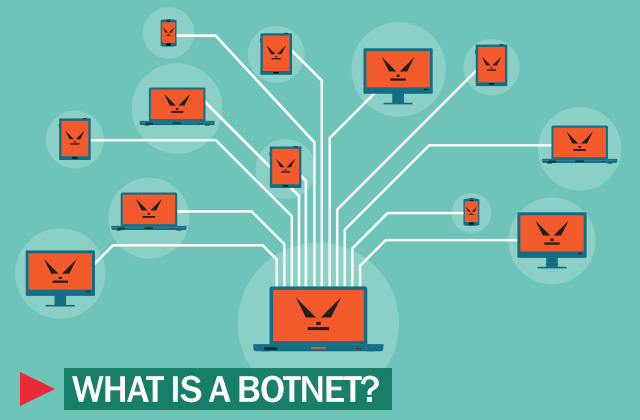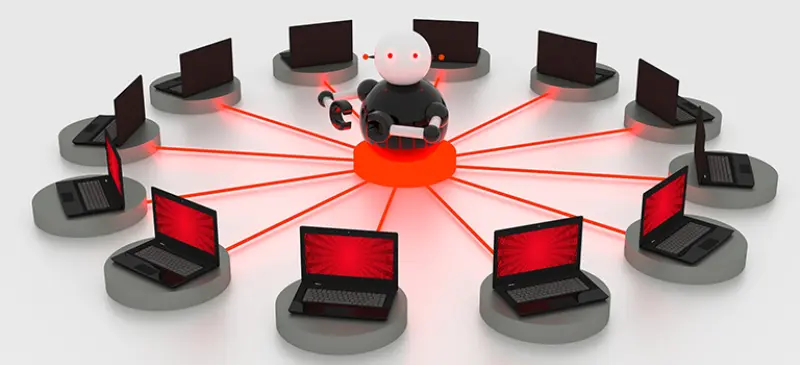In the evolving landscape of cybersecurity, one of the most notorious threats is the “botnet.” This term has gained significant traction over the years as cybercriminals increasingly rely on these complex networks to carry out a variety of malicious activities. In this 3000-word article, we’ll explore what botnets are, how they work, the threats they pose, and what measures can be taken to prevent or mitigate them. By the end of this article, you will have a comprehensive understanding of botnets and their relevance in today’s digital world.
Introduction to Botnets

The term “botnet” is derived from the words “robot” and “network.” A botnet is essentially a network of devices (also known as bots or zombies) that are infected with malware and remotely controlled by a cybercriminal or hacker. These devices can range from personal computers and servers to Internet of Things (IoT) devices such as smart home appliances. Once compromised, the devices become part of a larger network and are typically used to execute coordinated cyber-attacks.
The concept of botnets is not new; they have been around since the early 2000s. However, their sophistication and scale have evolved dramatically. Today, botnets are used for a wide range of malicious activities, including Distributed Denial of Service (DDoS) attacks, data theft, phishing campaigns, and cryptocurrency mining. The widespread adoption of internet-connected devices has only made botnets more dangerous, as cybercriminals have more opportunities to hijack vulnerable systems.
The Anatomy of a Botnet
A botnet consists of several key components that allow it to function. Understanding these components is crucial for comprehending how botnets operate and how they can be dismantled.
a. Botmaster
At the top of the hierarchy is the “botmaster,” also known as the “herder.” This individual or group controls the botnet remotely. The botmaster is responsible for infecting devices, issuing commands, and coordinating attacks. Communication between the botmaster and the compromised devices is typically carried out through command-and-control (C2) servers.
b. Bots (Zombies)
The bots are the individual devices that have been compromised and are part of the botnet. These devices continue to function normally in many cases, making it difficult for the owners to detect that they have been compromised. Once under control, bots follow the instructions issued by the botmaster.
c. Command-and-Control (C2) Servers
The C2 servers are the communication hubs for the botnet. The botmaster sends commands to the bots via these servers, and the bots relay information back. Some advanced botnets use decentralized methods for communication, making them harder to shut down.
d. Infection Mechanism
This refers to the malware or exploit used to compromise devices and add them to the botnet. Common methods include phishing attacks, software vulnerabilities, and infected downloads.
Types of Botnets

Botnets are not one-size-fits-all. Over the years, cybercriminals have developed various types of botnets tailored to specific tasks and attack vectors. Below are some of the most common types:
a. DDoS Botnets
These botnets are designed to carry out Distributed Denial of Service (DDoS) attacks. By overwhelming a target server with an enormous amount of traffic, the botnet can render the service unavailable to legitimate users. Famous DDoS botnets include Mirai, which specifically targeted IoT devices like security cameras and routers.
b. Spam Botnets
Spam botnets are used to distribute vast amounts of spam emails, often containing phishing links or malware attachments. One of the most notorious spam botnets is the Rustock botnet, which was responsible for sending billions of spam emails daily before it was taken down.
c. Click Fraud Botnets
These botnets are used in advertising fraud schemes. Bots are instructed to click on pay-per-click (PPC) ads on websites, inflating the ad revenue for the botmaster while costing advertisers millions in wasted marketing budgets.
d. Credential Stuffing Botnets
Credential stuffing botnets are employed to carry out automated login attempts on websites. These botnets use lists of stolen username and password combinations to attempt logins across multiple sites, exploiting users who reuse credentials.
e. Cryptojacking Botnets
Cryptojacking botnets use the processing power of compromised devices to mine cryptocurrencies like Bitcoin or Monero. This type of botnet often remains undetected for long periods, as it doesn’t cause immediate damage but severely reduces the performance of infected devices.
Common Uses of Botnets

Botnets are extremely versatile tools in the world of cybercrime. Their most common uses include:
a. Distributed Denial of Service (DDoS) Attacks
DDoS attacks are among the most common uses of botnets. In a DDoS attack, the botmaster instructs the bots to flood a target server or network with traffic, causing it to crash or become unavailable to legitimate users. These attacks can cripple businesses, governments, and other organizations.
b. Spamming
Botnets are widely used to send out spam emails. These emails often contain malicious links, phishing attempts, or malware attachments. Because botnets have access to millions of devices, they can send spam at a massive scale.
c. Click Fraud
In click fraud schemes, botnets are used to generate fake clicks on ads to fraudulently inflate ad revenues. This type of attack is particularly damaging to advertisers who pay for each click on their ads.
d. Data Theft
Botnets can be used to steal sensitive data such as login credentials, personal information, and financial data. Cybercriminals often deploy bots to infiltrate systems, extract valuable information, and send it back to the botmaster.
e. Cryptocurrency Mining
Cryptojacking botnets use the processing power of infected devices to mine cryptocurrencies without the device owner’s knowledge. This type of botnet is particularly hard to detect and can operate for long periods, draining the performance of the compromised device.
Notable Botnet Attacks
Over the years, botnets have been responsible for some of the most damaging cyber-attacks in history. Here are a few notable examples:
a. The Mirai Botnet
The Mirai botnet is perhaps the most famous botnet attack to date. In 2016, it took down major websites such as Twitter, Reddit, and Netflix by launching a massive DDoS attack. Mirai specifically targeted IoT devices, exploiting their weak security.
b. The Storm Botnet
Active between 2007 and 2008, the Storm botnet was one of the largest botnets ever observed. It was primarily used for spamming and DDoS attacks. At its peak, the Storm botnet consisted of millions of infected devices.
c. The Rustock Botnet
Rustock was a notorious spam botnet that sent billions of spam emails every day. It operated for several years before it was dismantled in a coordinated effort by law enforcement and tech companies in 2011.
d. The Conficker Worm
Conficker was a highly sophisticated worm that infected millions of computers worldwide in 2008. It created a botnet that was capable of stealing data and executing DDoS attacks. Despite efforts to shut it down, remnants of the Conficker botnet still exist today.
How Botnets Work

The functioning of a botnet is akin to a well-coordinated army. The botmaster is the general, and the individual bots are soldiers following orders. Here’s a step-by-step breakdown of how botnets work:
a. Infection
First, the cybercriminal needs to infect devices with malware to add them to the botnet. This is often done through phishing emails, drive-by downloads, or exploiting software vulnerabilities.
b. Connection to Command-and-Control (C2) Servers
Once a device is infected, it connects to the C2 server, where it receives instructions from the botmaster. The C2 server acts as the brain of the operation, directing the botnet’s activities.
c. Execution of Commands
The botmaster sends commands to the bots, instructing them to carry out specific tasks such as launching a DDoS attack, sending spam emails, or mining cryptocurrency.
d. Reporting Back
Bots often report back to the C2 server with data collected from the infected devices, such as stolen login credentials or financial information.
How Devices are Infected
Understanding how devices become part of a botnet is key to protecting against infection. Here are some of the most common methods:
a. Phishing Attacks
Phishing emails often contain malicious links or attachments that, when clicked, install malware on the recipient’s device. This malware then connects the device to the botnet.
b. Exploiting Software Vulnerabilities
Cybercriminals often exploit known vulnerabilities in software to infect devices. These vulnerabilities can exist in operating systems, browsers, or applications.
c. Drive-By Downloads
Drive-by downloads occur when a user visits a compromised website, which automatically downloads and installs malware without the user’s consent or knowledge.
d. Malvertising
Malvertising involves the use of online ads to deliver malware. These ads appear legitimate, but clicking on them initiates the download of malicious software.
e. Infected USB Drives
Another method is to distribute malware via infected USB drives. Once the drive is plugged into a device, the malware spreads to the system.
How to Protect Yourself from Botnets
Fortunately, there are several steps individuals and organizations can take to protect themselves from botnets:
a. Regular Software Updates
Keeping software up to date is one of the most effective ways to protect against botnet infections. Updates often contain patches for security vulnerabilities that botnets exploit.
b. Use of Firewalls and Antivirus Software
Firewalls can block unauthorized access to your system, while antivirus software can detect and remove malware before it causes harm.
c. Avoid Phishing Attacks
Be cautious when opening emails from unknown senders or clicking on suspicious links. Phishing is a common way for botnet malware to spread.
d. Secure IoT Devices
Many IoT devices have weak security settings by default. Changing default passwords and keeping firmware updated can prevent IoT devices from becoming part of a botnet.
Botnet Detection and Mitigation
Detecting a botnet infection is not always easy, but there are some signs to watch for:
a. Unusual Network Traffic
Botnets often generate high volumes of network traffic, especially during DDoS attacks. Monitoring network traffic for unusual spikes can help detect botnet activity.
b. Slow Device Performance
If your device is part of a cryptojacking botnet, it may experience slower performance as the botnet consumes processing power for cryptocurrency mining.
c. Use of Anti-Botnet Tools
Specialized anti-botnet tools can scan for botnet malware and remove it from infected devices. These tools are often included in comprehensive security suites.
Legal and Ethical Implications of Botnets
The use of botnets is illegal in most jurisdictions, but enforcement is challenging due to the global nature of the internet. International cooperation is often required to track down botmasters, especially when they operate from countries with lax cybersecurity laws. Ethical concerns also arise when botnets are used for corporate espionage, nation-state attacks, or other forms of malicious activity.

